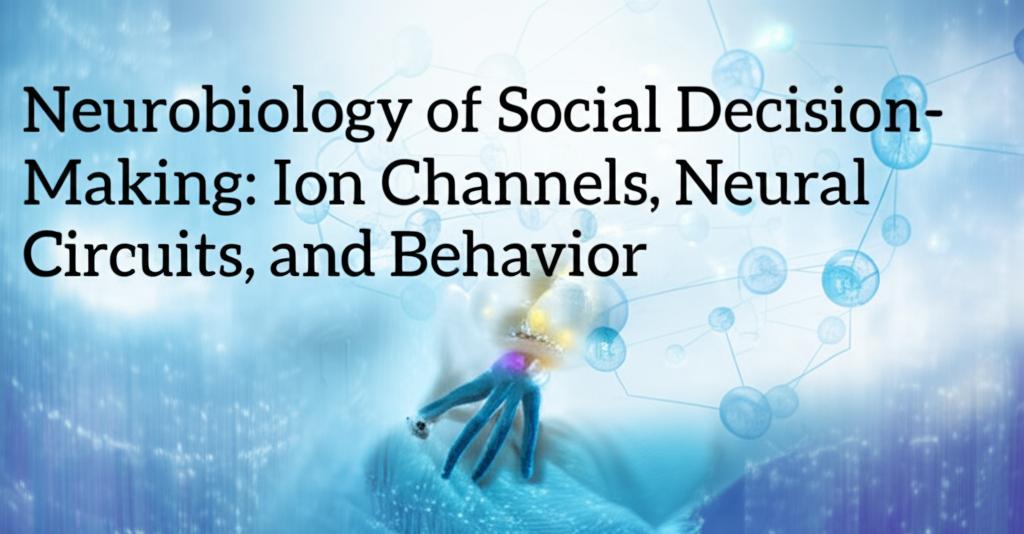Social decisions, the choices we make in the context of interactions with others, are fundamental to our lives. These decisions, ranging from cooperation and trust to competition and altruism, are governed by a complex interplay of ion channels, neural circuits, and ultimately, behavior. Recent research has significantly advanced our understanding of these neurobiological underpinnings.
Ion Channels: The Molecular Gatekeepers of Social SignalingAt the most fundamental level, ion channels, specialized proteins embedded in cell membranes, regulate the flow of ions, thereby controlling the excitability of neurons and the transmission of signals within the brain. While the direct role of specific ion channels in complex social decision-making is still an area of active research, their importance in neuronal function is undisputed. Mutations in ion channel genes have been linked to various neurological and neurodevelopmental disorders that often involve social deficits, such as autism spectrum disorder. For instance, studies suggest that ion channel-related genes may influence susceptibility to ASD, potentially impacting neuronal network function and contributing to variations in social-communicative behaviors. The precise mechanisms by which ion channels contribute to the nuances of social cognition are a key focus for future research, aiming to understand how their activity translates to specific social behaviors.
Neural Circuits: The Brain's Social NetworkSocial decision-making involves a network of interconnected brain regions rather than a single "social center." Key areas consistently implicated include:
- Prefrontal Cortex (PFC): Often considered the brain's executive control center, the PFC, particularly regions like the dorsolateral PFC (dlPFC) and dorsomedial PFC (dmPFC), is crucial for evaluating options, considering future consequences, and integrating social norms and past experiences into decisions. It plays a significant role in higher-order thinking processes like planning and reasoning in social contexts. Recent studies highlight how specific pathways originating in the dmPFC can orchestrate competitive and submissive behaviors. For example, distinct neuronal populations in the dmPFC project to different downstream areas to promote or suppress social competition, with an antagonistic interplay between these pathways.
- Amygdala: This region is heavily involved in processing emotions, particularly fear and threat, but also plays a critical role in evaluating social cues, trust, and the value of social rewards. Studies have shown that the basolateral amygdala is involved in prosocial behavior, and its interaction with other regions like the hippocampus can modulate social tendencies. Oxytocin, a neuropeptide known for its role in social bonding, can influence amygdala activity, reducing its response to threatening social stimuli and increasing trust.
- Limbic System (including the Hippocampus): Beyond the amygdala, the broader limbic system, including the hippocampus, contributes to social decision-making by processing emotions and memories related to social encounters.
- Striatum (including the Nucleus Accumbens): This area is central to the brain's reward system. The nucleus accumbens (NAc) is key in mediating goal-directed approach behaviors, including approaching social targets. Dopaminergic neurons originating in the ventral tegmental area (VTA) project to the NAc and play a crucial role in modulating social approach and reward. The caudate nucleus, another part of the striatum, helps register social prediction errors, guiding decisions about reciprocity.
- Anterior Cingulate Cortex (ACC) and Insula: These regions are involved in processing social pain, empathy, fairness, and monitoring for norm violations. The anterior insula, for example, is activated during negative social interactions and can influence decision-making in social games.
- Dopaminergic Circuits: The midbrain dopamine system is central to reward processing and motivation, which are critical components of social decision-making. Recent research in mice has revealed sexually dimorphic dopaminergic circuits that determine social preferences. For instance, in male mice, a VTA-NAc reward circuit driven by reproductive needs mediates preference for female interactions, while a VTA-mPOA (medial preoptic area) defense circuit, responsive to survival threats, mediates preference for male interactions. The balance between these circuits dictates social choices. In females, the VTA-NAc circuit appears to mediate both male and female social preferences, with different firing modes of dopamine neurons dictating the specific preference.
Social behavior is not static; it's remarkably flexible and adapts to context, internal states (like reproductive needs or stress levels), and social experience. The brain achieves this flexibility through plasticity in the underlying neural circuits. This can involve changes at the level of individual neurons, the strength of connections (synapses) between them, and ultimately the input-output relationships of entire circuits.
Neuromodulators like oxytocin and serotonin play a vital role in "tuning" these social brain networks. Oxytocin, for instance, can enhance prosocial behavior by increasing attention to social partners and modulating amygdala activity.
Comparative Perspectives and Future DirectionsMuch of our understanding of the neurobiology of social decision-making comes from comparative studies across species, including humans, non-human primates, and rodents. This research reveals that while some mechanisms underlying social behavior are deeply conserved across evolutionary history (deep homology), others appear to be more unique to primates and humans.
The use of game theory in laboratory settings has provided valuable tools to operationalize and study social decisions. Combining these paradigms with advanced neuroscience techniques—such as fMRI, optogenetics (using light to control neuron activity), chemogenetics (using engineered receptors to control neuron activity), electrophysiology (recording neural activity), and neural circuit tracing—is continuously refining our understanding.
Future research will likely focus on:
- Further dissecting the precise roles of specific ion channels in shaping social neural circuit activity and behavior.
- Understanding how different neural circuits interact and integrate information to produce complex social decisions.
- Elucidating the molecular and cellular mechanisms underlying the flexibility and plasticity of social behavior.
- Translating these findings to better understand and potentially treat social deficits in neuropsychiatric disorders.
By continuing to explore the intricate connections between ion channels, neural circuits, and behavior, scientists are paving the way for a more comprehensive understanding of the social brain and the decisions that shape our interactions and societies.

